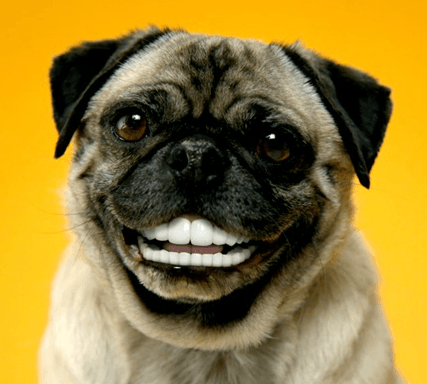Teeth brushing for Pugs is another program that you should start during her first few weeks in your home. Her baby teeth are still in place. Obviously they are strong and clean, but routine brushing at an early age will accustom her to that grooming task, which will be better accepted later.
Canine preventive dentistry can stop periodontitis (gum inflammation), which has long been neglected by owners. Untold numbers of small dogs are anesthetized to clean their teeth and extract those that are loose, covered with plaque and tartar, and beyond saving.
Many older canines’ health problems, such as nephritis (degenerative kidney disease), cardiac diseases, arthritis, and other conditions are related to periodontitis. Food particles gather between teeth, and oral bacteria grow in this warm, moist environment. Those germs eventually infect the soft gum tissues. The infection travels through the bloodstream to various susceptible organs.
Encourage Pugs to chew on firm objects such as nylon bones and hard-twisted rawhide sticks, dry dog food, and hard biscuits. Today, pet supply stores prominently display “dental chews” specifically designed to increase the tooth action and help remove or prevent plaque.
Owners are beginning to recognize that chewing firm objects is an important part of canine preventive dentistry, but that isn’t enough. For many years, veterinarians have suggested wrapping a bit of gauze tightly around an index finger, dampening it with 2 percent hydrogen peroxide, and scrubbing the surface of the teeth. That technique works well, but most dogs hate it! The peroxide foams, it tastes horrible, and many dogs will not tolerate such preventive therapy.
More recently, preventive oral hygiene has made strides, and canine tooth brushing is now recognized as a beneficial part of
your companion’s grooming. Brushing is an easily accomplished task that takes only a minute or two. When employed several times a week, it possibly prevents tartar and plaque formation. Sound teeth reduce bad breath and minimize the need for professional cleaning and extractions. Brushing makes good sense because you are avoiding veterinary fees and thereby saving dollars in the bargain.
A new periodontitis vaccine discussed in the Pug Health and Nutrition chapter may prove to be a significant additional tool for infected gums. However, only brushing will remove existing debris from between teeth, prevent discoloration, and stop tartar from beginning to form.
Tooth Brushing Basics
- Only the outside surface of the teeth need to be brushed.
- You do not need to pry open Pugs’ mouth.
- Use either a finger-brush ($3—$5) that slips over your index finger or a standard canine toothbrush ($4.50).
- Always use canine toothpaste ($4—$6), in flavors approved by Muggs. Mint-flavored, human toothpaste should not be substituted, and its use may defeat the entire brushing program. Dog toothpaste tastes like meat; human toothpaste tastes like peppermint, which is not acceptable to Pugs.
- Apply a short ribbon of toothpaste to the finger-brush (or toothbrush), slip the brush between her lips, and brush the incisors, canines, and molars. Be quick and thorough.
- Pugs will become accustomed to this routine in a few days, and the flavor of the toothpaste will encourage her participation. Tooth brushing should definitely become a part of Pugs’ routine grooming sessions.

